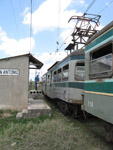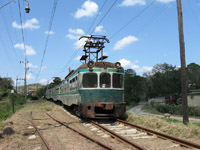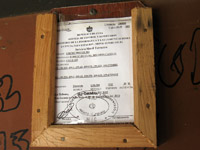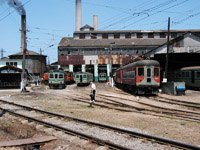
Brill+Brill Train
The cars 3008 and 3006 are two of the last remaining 1920 original Brill cars. This cars were extensively rebuilt at the local shops.
( 2002 )

GE+Brill+Brill Train
An electric loco helps out whenever motors on the original Brill cars fail.
( 2002 )

Sarria Train
The Casa Blanca Terminal is located across the narrow strait from the Havana city center, and could be accessed from the latter by a frequently ran ferry service. This arrangement a leftover from the times when the United Railways, the English company that operated railroads in the Havana Province during the first half of the XXth century, did not allow Hershey trains into Havana proper.
( 2002 )

At the time of this photograph five daily trains operated via the main line between Havana and Matanzas.
( 2002 )

Sarria Train
These 1944 Spanish cars (rebuilt in the 1970s) were delivered second hand from Barcelona starting from 1998. Habana Vieja (Havana’s Old Town) is visible across the narrow strait, behind the station.
( 2010 )

Sarria Train
At the time of this photograph the service on this part of the line was temporary suspended. The train 513+813+903 was trapped at the Casa Blanca terminal, sitting idle for weeks. Note a lonely security guard on a lookout in the front. Mind the gap when boarding a train at this station!
( 2010 )

By 2010 the number of through trips via the main line between Havana and Matanzas was reduced to three. If you lucky. A notice on the right informs of a temporary suspension of the train service, with the only official explanation given to the public being: “No train service until further notice”.
( 2010 )

Sarria Train
Despite their appearance, the pictured tracks are used in the regular service. The dust over tracks accumulated during a period of a temporary service suspension.
( 2010 )

A semi-mixed traffic right-of-way through the streets of Casa Blanca. The train service is temporarily suspended.
( 2010 )

Brill+Brill Train
( 2002 )

Brill+Brill Train
The Guanabo Station and passing point precedes the Playa del Este (the Eastern Beach) branch. Trains running between Hershey and Playa del Este need to change points at Guanabo. Correction: according to the timetable in effect at the time of this photo, there was, in fact, only one train. The other two trains serving Playa del Este were summer-only trains connecting the beach and Havana (La Coubre).
( 2002 )

Workcars
( 2002 )

This is a somewhat historic photograph, as the Hershey Sugar Mill is still pictured churning out smoke. The Mill will be closed in three months.
( 2002 )

Brill+Brill Train
The cars 3008 and 3006 are two of the last remaining 1920 original Brill cars. This cars were extensively rebuilt at the local shops. At the time of this photo, the 3006 had working motors, while the 3008 acted as a driving trailer.
( 2002 )

Brill Car
The car 3009 is the most extensively rebuilt out of the last remaining 1920 original Brill cars.
( 2002 )

The Hershey Station, located near the Hershey Sugar Mill, acts as the railroad's service hub, which is clearly reflected in this 2002 timetable. With the exception of the nighttime service, the timetable will not change much until 2007, despite the fact that the Hershey Sugar Mill will close in 07.2002.
( 2002 )

Sarria Train
All mainline trains operating between Havana and Matanzas are traditionally scheduled to meet at the Hershey hub station. There is excessive running time embedded in a timetable, so at the time point stations such as Hershey, early arrivals (up to 15 min.), and late departures (up to 30 min.) are a norm. This allows crews to linger around stations and socialize for prolonged periods of time, while passengers wait on board of trains.
( 2010 )

Sarria Train
Hershey Railway operates three and two-car Sarria consists, as well as single cars. While three-car trains are usually assigned to the mainline Havana to Matanzas service, with two-car trains or single cars working the branches, there is no rule, and any type of a consist could be found on any of the branches at any time. On a given day, a two-car train 501+401 is seen operating on the main line. Unfortunately, this train broke down, and it will be send to the Depot. The next train to Matanzas will depart in five and half hours.
( 2010 )

Sarria Train
( 2010 )

A dormant Hershey Sugar Mill after the closure.
( 2010 )

Practically every station is equipped with a shelter. Considering total unpredictability of the train service, the shelters could literally become temporary homes for stranded passengers - for hours and days at a time. In a given case, the scheduled train didn’t show up – the author gave up after an hour wait, and walked away with this train-less photo. It was later discovered, that a train broke down, and was diverted to the Depot at Hershey. The passenger in this photo faces a five-and-half hour wait.
( 2010 )

Sarria Train
A junction immediately west of the Jibacoa Station. A pictured train is speeding away via the mainline toward Hershey and Havana, while a track branching off to the right leads to Santa Cruz del Norte.
( 2010 )

Sarria Train
The Jibacoa Station and passing point precedes the Santa Cruz del Norte branch. Trains running between Hershey and Santa Cruz del Norte need to change points at Jibacoa. A close examination of the overhead reveals that at the time of this photo only the middle track remained possible for the electric trains’ operation. A pictured train makes an unscheduled stop at the location that is not a designated stop - a common practice on the Hershey system.
( 2010 )

Brill+Brill Train
At the time of this photo all three spurs at the passing point were still available for electric trains' operation.
( 2002 )

Sarria Train
A mainline Matanzas – Havana train arrives at the Jibacoa junction station. By 2010 the station building was gone, with only a foundation remaining.
( 2010 )

Sarria Train
A relatively recently delivered (at the time of this photo) Sarria train still boasts freshly-looking Spanish paint job.
( 2002 )

Sarria Train
( 2010 )

Most stations on the system are on-request stops. As transportation options in Cuba are scarce, there would almost always be someone waiting for at train even at the most remote stops. This means that trains make next-to-all designated (and in some cases not designated) stops.
( 2010 )

Sarria Train
A Havana-bound train appears down the track from the Calderon Station. Luckily, in this case the train is only about 20 minutes late.
( 2010 )

Sarria Train
A Havana-bound train 614+814+505.
( 2010 )

Sarria Train
When initially opened in the 1920s, the railroad’s original role was meant to transport sugar cane or sugar products, not passengers. Consequently, many stops are located away from settlements, but rather at the crossings with rural roads or footpaths leading to the villages nearby. This provides for a middle-of-nowhere feel at most stations.
( 2010 )

Sarria Train
A train enters the Concuni Station and passing point (visible in the background).
( 2010 )

Sarria Train
( 2010 )

Sarria Train
As most stations are equipped with single-door-wide high platforms, the front door of a train is usually the sole door used for passenger boardings. In this photo, the door in question remains opened even though the train is moving between stations.
( 2010 )

Sarria Train
( 2010 )

Even though there are many bridges on the system, there are only two railroad overpasses over roads. This one is near the Canasi Station.
( 2010 )

Sarria Train
A Havana-bound train approaches the Canasi Station.
( 2010 )

Sarria Train
A train stops at the Canasi Station. While the front car is in the station, the last car is left hanging on the overpass. Note, that boarding through operator’s cab doors is a common practice on the Hershey system, and apply that to a given situation :)
( 2010 )

Sarria Train
The little town of Arcos de Canasi is the second largest settlement after Hershey on the mainline between Havana and Matanzas outside the greater Havana area (all other sizeable towns are served by the side branches). The Canasi Station is the last stop for some trips originating at Hershey. In addition, short turn trips between Havana (Casa Blanca) and Canasi were implemented as a part of the 2007 service cuts, but were suspended soon thereafter.
( 2010 )

Brill+Brill Train
Many bridges along the line provide for atmospheric photographic opportunities.
( 2002 )

Sarria Train
A train passes through a passing point and a freight yard outside of the San Antonio Station.
( 2010 )

Sarria Train
A Havana-bound train 614+814+505 approaches the San Antonio Station.
( 2010 )

Sarria Train
A train blocks off a local road as it stops at the station. No harm done, as at six daily trains, there is by far more train traffic than motorized traffic at the given crossing.
( 2010 )

Sarria Train
As most stations are equipped with single-door-wide high platforms, the front door of a train is usually the sole door used for passenger boardings.
( 2010 )

Sarria Train
( 2010 )

The entire village and the station of Margot fits into one shot.
( 2010 )

Sarria Train
A Havana-bound train 614+814+505 approaches the Margot Station.
( 2010 )

Sarria Train
( 2010 )

Sarria Train
Boardings through a cab door directly onto / from the trackbed is a common practice throughout the system.
( 2010 )

Sarria Train
Many passing points on the system are no longer used for regular service moves. Unused spurs are usually turned into storage tracks for semi-abandoned equipment.
( 2010 )

Sarria Train
( 2010 )

Sarria Train
( 2010 )

Sarria Train
Train operators treat the timetable as a mere suggestion. Late departures and early arrivals at terminals and time points are a norm. Thus, at stations located within the proximity of time points, one could reliably expect a train to be late for trips originating out of the time point, and early for trips destined for the time point. The Mena Station is the second stop west of the Matanzas Terminal. In a given case a Havana-bound train out of Matanzas will be 25 min late.
( 2010 )

Sarria Train
A Havana-bound train appears down the track from the Mena Station. The train is only 25 minutes late.
( 2010 )

Sarria Train
( 2010 )

Sarria Train
A Havana-bound train 614+814+505 leaves the Mena Station.
( 2010 )

Brill+Brill Train
Waiting for the Hershey Train is like playing a lottery.
( 2002 )

Workcar
An overhead patchwork is a daily necessity.
( 2002 )

Workcar
( 2002 )

Workcar
( 2002 )

Sarria Train
The Matanzas Terminal building boasts a somewhat curious design, as it is the only station on the system with a canopy extending over the two east-end cars of the train.
( 2010 )

Sarria Train
The Matanzas Terminal is one of only two stations on the system, equipped with a continuous high platform (the other one is Hershey). All other stations have single-door-wide high platforms. High platforms were installed system-wide with the arrival of the high floor Sarria trains from 1998 on.
( 2010 )

Sarria Train
A canopy and a high platform accommodate the two east-end cars only. The third car (the west-end car) doesn’t fit into the station. Despite that all doors on the west-end car are opened. Mind the gap!
( 2010 )

Sarria Train
( 2010 )

Sarria Train
An interior lighting.
( 2010 )

Sarria Train
Note ventilation grids at both ends of cars - a unique feature of Sarria cars' design.
( 2010 )

Sarria Train
( 2010 )

Sarria Train
A license for a train radio is issued annually by the Cuban Ministry of Information and Communication, individually for each motor car on the train. Cuban airways are under a tight government control.
( 2010 )

Sarria Train
( 2010 )

Brill Car
A junction between the mainline and the Bainoa branch. The section of the Bainoa branch immediately south of Caraballo is dismantled, nevertheless, this branch is still referred to as the Bainoa branch. A train in the background is operating on the mainline, while the car 3009 in the front is about to depart for Caraballo.
( 2002 )

Even though there are many bridges on the system, there are only two railroad overpasses over roads. This one is near the Rubion Station. The road in question is the one that more-or-less follows most of the mainline railroad track between Hershey and Matanzas. The state of this road, in some places only possible for tractors, insures the survival of the railroad.
( 2010 )

Brill+Brill Train
A mixed traffic right-of-way via the street through the town of Caraballo is one of the four sections with train street running around the system (only the sections in Caraballo and Casa Blanca carry passenger service).
( 2002 )

A direct competitor to the Hershey Interurban train. While it is almost impossible to follow tracks of the Hershey Railroad by road directly (either due to the geography, or due to the state of the roads), a non-direct bus service to major towns connected by the railroad is easily possible via other roads.
( 2010 )

Sarria Train
The Talleres Calle 7 Station is located next to the Hershey Sugar Mill and the railroad's Depot, within 10 min. walk from the mainline Hershey Station. It is a terminal for the Jaruca Shuttle and a few selected trips to Caraballo, Santa Cruz del Norte and Canasi. The station was meant to serve the workers of the mill, while the latter was still functional. Nevertheless, after the mill’s closure trains are still operated in and out of this terminal. All transferring passengers must walk to the Hershey Station to catch the mainline trains.
( 2002 )

( 2002 )

Sarria, Brill Cars
Three months before the closure of the Hershey Sugar Mill, the smoke stacks in the background of the Depot are still churning out smoke.
( 2002 )

Sarria Cars
There are different patterns in the Sarria cars' design. At least six cars, including the cars 403+402 in this picture, represent the older design trend from the 1940s. These cars are notable for single leaf doors and two windows between the doors. Other cars represent the newer design trend from the 1970s, which includes double leaf doors and one window between the doors.
( 2002 )

GE Locomotive, Sarria Cars
The car 707 is of the unique design. It has controls at both ends, allowing for a double-ended solo operation. Furthermore, the headlights are positioned under the windshield, rather than on the top of the roof. It is speculated that this car was rebuilt from a trailer. Sarria trailers lack headlights as they are operated sandwiched between motor cars.
( 2002 )

Brill Car
At the time of this photograph the car 3007 was one of the group of the last four remaining 1920 original Brill cars, numbered 3006-3009. This car, however, will not be as lucky as the other three cars – it will no longer be maintained in working condition, and thus will not be preserved.
( 2002 )

Brill Trailer
( 2002 )

GE Locomotive
( 2002 )

Brissoneau Locomotive
( 2002 )

Russian Diesel Locomotive TEM2
( 2002 )

Brill & Sarria Cars
“The electric railroad rejuvenates”. The sign celebrates the arrival in 1998 of the second hand 1944 Spanish Sarria cars that replaced the original 1920 Brill cars.
( 2002 )

( 2002 )

GE Locomotive, Sarria Cars
The smoke stacks of the Hershey Sugar Mill behind the Depot are idle.
( 2010 )

Sarria Cars
The car 707 is of the unique design. It has controls at both ends, allowing for a double-ended solo operation. Furthermore, the headlights are positioned under the windshield, rather than on the top of the roof.
( 2010 )

GE Locomotive, Sarria Cars
At the time of this photo the loco 20808 was the only remaining operable electric locomotive out of about five such locomotives on the property.
( 2010 )

GE Locomotive
The controls of the 20808.
( 2010 )

GE Locomotive
( 2010 )

GE Locomotive
( 2010 )

Brill Car
The car 3006 is one of the last three (at the time of this photo) remaining 1920 original Brill cars. It is known as the last Brill car to be used in regular passenger service, as it worked the lightly traveled branches until about 2007.
( 2010 )

Brill Car
Even though at the time of this photograph the car 3006 was still in a semi-operable condition, the use of this car was no longer warranted after the service cuts that took place around 2007.
( 2010 )

Brill Car
( 2010 )

Brill Car
( 2010 )

Brill+Brill Train
The cars 3008 and 3009 are the two of the last three (at the time of this photo) remaining 1920 original Brill cars. The cars were extensively rebuilt in local shops and are maintained in a fair condition as they are operated as a tourist train for foreign tourists. The tourist train is usually towed by an electric locomotive.
( 2010 )

Brill Car
The car 3009 is the most extensively rebuilt car out of the three (at the time of this photo) last remaining 1920 original Brill cars.
( 2010 )

Brill+Brill Train, Workcar
At the time of this photo the old Brill cars were usually to be found stored in the storage yard to the north of the Hershey Sugar Mill (the active Depot is located to the south of the mill).
( 2010 )

Brill Car
The car 3008 on a tourist trip.
( 2002 )

Brill Car
( 2002 )

Brill Car
An emergency cord.
( 2002 )

Passenger Platform Trailer
( 2010 )